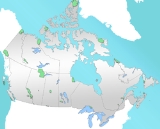
List of Canadian national parks
Encyclopedia
This is a list of National Parks of Canada. Canadian National Parks preserve both spectacular and representative areas of the country, located in every one of the nation's 13 provinces and territories. The goal of the national park service is to create a system of protected areas which represent all the distinct natural regions of the country. Parks Canada
the governing and administration body for the system has developed a plan identifying 39 different regions it aims to represent. In 2005, Parks Canada reported that the system was more than 60% complete. Canada's parks are managed primarily to protect the ecological integrity of the park, and secondarily to allow the public to explore, learn about and enjoy Canada's natural spaces. Feasibility studies are currently underway for establishing further national parks in several areas, including Wolf Lake in Yukon
, South Okanagan
-Lower Similkameen
in British Columbia
and the Manitoba
Lowlands (north-western Lake Winnipeg
).
There are currently 36 National Parks and 6 National Park Reserves (including Kluane National Park and Reserve
, which is considered both a National Park and a Reserve). This list also includes the country's four National Marine Conservation Areas
(NMCAs), the lone National Landmark
, and four future parks.
(NMCAs) are a relatively new addition to the park system. These areas have a different mandate than their terrestrial counterparts. They are designed for sustainable use, although they usually also contain areas designed to protect ecological integrity. The government has announced plans to add five more Marine parks to the system as part of the Marine Conservation Areas Act. The first to be officially announced was Lake Superior National Marine Conservation Area
, although a date of opening has not yet been revealed. Other areas under negotiation are the southern Strait of Georgia
and Gwaii Haanas in British Columbia
and there are discussions to study the feasibility of an area on the southern coast of Newfoundland
.
program was established in 1978 but has not yet been expanded beyond a single property. Landmarks were intended to protect specific natural features considered "outstanding, exceptional, unique, or rare to this country. These natural features would typically be isolated entities and of scientific interest."
s (Category II) under the IUCN's Protected Area Management Categories.
Parks Canada
Parks Canada , also known as the Parks Canada Agency , is an agency of the Government of Canada mandated to protect and present nationally significant natural and cultural heritage, and foster public understanding, appreciation, and enjoyment in ways that ensure their ecological and commemorative...
the governing and administration body for the system has developed a plan identifying 39 different regions it aims to represent. In 2005, Parks Canada reported that the system was more than 60% complete. Canada's parks are managed primarily to protect the ecological integrity of the park, and secondarily to allow the public to explore, learn about and enjoy Canada's natural spaces. Feasibility studies are currently underway for establishing further national parks in several areas, including Wolf Lake in Yukon
Yukon
Yukon is the westernmost and smallest of Canada's three federal territories. It was named after the Yukon River. The word Yukon means "Great River" in Gwich’in....
, South Okanagan
Okanagan
The Okanagan , also known as the Okanagan Valley and sometimes as Okanagan Country is a region located in the Canadian province of British Columbia defined by the basin of Okanagan Lake and the Canadian portion of the Okanagan River. As of 2009, the region's population is approximately 350,927. The...
-Lower Similkameen
Similkameen River
The Similkameen River runs through southern British Columbia, eventually discharging into the Okanogan River near Oroville, Washington in the United States. The river is approximately long, and its drainage basin is in area...
in British Columbia
British Columbia
British Columbia is the westernmost of Canada's provinces and is known for its natural beauty, as reflected in its Latin motto, Splendor sine occasu . Its name was chosen by Queen Victoria in 1858...
and the Manitoba
Manitoba
Manitoba is a Canadian prairie province with an area of . The province has over 110,000 lakes and has a largely continental climate because of its flat topography. Agriculture, mostly concentrated in the fertile southern and western parts of the province, is vital to the province's economy; other...
Lowlands (north-western Lake Winnipeg
Lake Winnipeg
Lake Winnipeg is a large, lake in central North America, in the province of Manitoba, Canada, with its southern tip about north of the city of Winnipeg...
).
There are currently 36 National Parks and 6 National Park Reserves (including Kluane National Park and Reserve
Kluane National Park and Reserve
Kluane National Park and Reserve are two units of Canada's national park system, located in the extreme southwestern corner of Yukon Territory. Kluane National Park Reserve was established in 1972, covering 22,016 square kilometres....
, which is considered both a National Park and a Reserve). This list also includes the country's four National Marine Conservation Areas
National Marine Conservation Areas
National Marine Conservation Areas is a Parks Canada programme responsible for marine areas managed for sustainability and containing smaller zones of high protection. They include the seabed, the water itself and any species which occur there...
(NMCAs), the lone National Landmark
National landmark
A National landmark is a site identified by a national authority as one possessing nationally–significant natural, historic, or scientific resources...
, and four future parks.
National Parks and National Park Reserves
A National Park Reserve is an area that has been set aside with the intention of becoming a national park, pending the settlement of native land claims. Until then, they are managed as national parks under the National Parks Act.| Name | Photo | Location | Area | Established |
|---|---|---|---|---|
| Aulavik Aulavik National Park Aulavik National Park is a national park located on Banks Island in the Northwest Territories of Canada. It is known for its access to the Thomsen River, one of the most northerly navigable rivers in North America. The park is a fly-in park, and protects approximately of Arctic Lowlands at the... |
Northwest Territories Northwest Territories The Northwest Territories is a federal territory of Canada.Located in northern Canada, the territory borders Canada's two other territories, Yukon to the west and Nunavut to the east, and three provinces: British Columbia to the southwest, and Alberta and Saskatchewan to the south... |
1992 | ||
| Auyuittuq Auyuittuq National Park Auyuittuq National Park is a national park located on Baffin Island's Cumberland Peninsula, Qikiqtaaluk Region in Nunavut, the largest political subdivision of Canada. It features the many terrains of Arctic wilderness, such as fjords, glaciers, and ice fields... |
 |
Nunavut Nunavut Nunavut is the largest and newest federal territory of Canada; it was separated officially from the Northwest Territories on April 1, 1999, via the Nunavut Act and the Nunavut Land Claims Agreement Act, though the actual boundaries had been established in 1993... |
2001 | |
| Banff Banff National Park Banff National Park is Canada's oldest national park, established in 1885 in the Rocky Mountains. The park, located 110–180 kilometres west of Calgary in the province of Alberta, encompasses of mountainous terrain, with numerous glaciers and ice fields, dense coniferous forest, and alpine... |
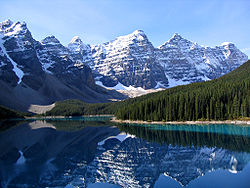 |
Alberta Alberta Alberta is a province of Canada. It had an estimated population of 3.7 million in 2010 making it the most populous of Canada's three prairie provinces... |
1885 | |
| Bruce Peninsula Bruce Peninsula National Park Bruce Peninsula National Park is a national park on the Bruce Peninsula in Ontario, Canada. Located on a part of the Niagara Escarpment, the park comprises 156 square kilometres and is one of the largest protected areas in southern Ontario, forming the core of UNESCO's Niagara Escarpment World... |
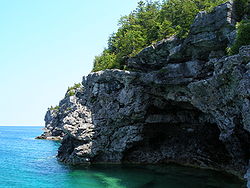 |
Ontario Ontario Ontario is a province of Canada, located in east-central Canada. It is Canada's most populous province and second largest in total area. It is home to the nation's most populous city, Toronto, and the nation's capital, Ottawa.... |
1987 | |
| Cape Breton Highlands Cape Breton Highlands National Park Cape Breton Highlands National Park is located on northern Cape Breton Island in the province of Nova Scotia. One-third of the Cabot Trail passes through the park featuring spectacular ocean and mountain views. The park was the first National Park in the Atlantic provinces of Canada and covers an... |
Nova Scotia Nova Scotia Nova Scotia is one of Canada's three Maritime provinces and is the most populous province in Atlantic Canada. The name of the province is Latin for "New Scotland," but "Nova Scotia" is the recognized, English-language name of the province. The provincial capital is Halifax. Nova Scotia is the... |
1936 | ||
| Elk Island Elk Island National Park Elk Island National Park , is one of 43 national parks and park reserves administered by the Parks Canada Agency. This “island of conservation” is located 35 km east of Edmonton, Alberta along the Yellowhead Highway, which nearly bisects the park... |
 |
Alberta Alberta Alberta is a province of Canada. It had an estimated population of 3.7 million in 2010 making it the most populous of Canada's three prairie provinces... |
1913 | |
| Forillon Forillon National Park Forillon National Park, one of 43 national parks and park reserves across Canada, is located at the outer tip of the Gaspé Peninsula of Quebec and covers 244 km². Created in 1970, Forillon was the first national park in Quebec. The park includes forests, sea coast, salt marshes, sand dunes,... |
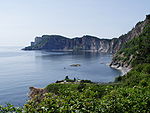 |
Quebec Quebec Quebec or is a province in east-central Canada. It is the only Canadian province with a predominantly French-speaking population and the only one whose sole official language is French at the provincial level.... |
1970 | |
| Fundy Fundy National Park Fundy National Park is located on the Bay of Fundy, near the village of Alma, New Brunswick. The Park showcases both seashore habitats and highland Acadian forests... |
New Brunswick New Brunswick New Brunswick is one of Canada's three Maritime provinces and is the only province in the federation that is constitutionally bilingual . The provincial capital is Fredericton and Saint John is the most populous city. Greater Moncton is the largest Census Metropolitan Area... |
1948 | ||
| Georgian Bay Islands Georgian Bay Islands National Park Georgian Bay Islands National Park consists of 63 small islands or parts of islands in Georgian Bay, near Port Severn, Ontario. The park was established in 1929. The total park area is approximately 13.5 km²... |
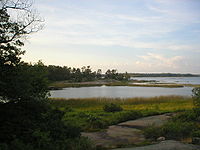 |
Ontario Ontario Ontario is a province of Canada, located in east-central Canada. It is Canada's most populous province and second largest in total area. It is home to the nation's most populous city, Toronto, and the nation's capital, Ottawa.... |
1929 | |
| Glacier Glacier National Park (Canada) Glacier National Park is one of seven national parks in British Columbia, and is part of a system of 43 parks and park reserves across Canada. It protects a portion of the Columbia Mountains. It also contains the Rogers Pass National Historic Site, designated for its importance in the construction... |
 |
British Columbia British Columbia British Columbia is the westernmost of Canada's provinces and is known for its natural beauty, as reflected in its Latin motto, Splendor sine occasu . Its name was chosen by Queen Victoria in 1858... |
1886 | |
| Grasslands Grasslands National Park Grasslands National Park is one of Canada's newer national parks, located in southern Saskatchewan, and one of 43 parks and park reserves in Canada's national park system... |
Saskatchewan Saskatchewan Saskatchewan is a prairie province in Canada, which has an area of . Saskatchewan is bordered on the west by Alberta, on the north by the Northwest Territories, on the east by Manitoba, and on the south by the U.S. states of Montana and North Dakota.... |
1981 | ||
| Gros Morne Gros Morne National Park Gros Morne National Park is a world heritage site located on the west coast of Newfoundland. At , it is the second largest national park in Atlantic Canada .... |
Newfoundland Newfoundland and Labrador Newfoundland and Labrador is the easternmost province of Canada. Situated in the country's Atlantic region, it incorporates the island of Newfoundland and mainland Labrador with a combined area of . As of April 2011, the province's estimated population is 508,400... |
1973 | ||
| Gulf Islands Gulf Islands National Park Reserve Gulf Islands National Park Reserve is the 40th National Park in a system of 43 parks and park reserves across Canada. Located in British Columbia's Gulf Islands, it covers 33 square kilometers over 16 islands. It also includes numerous islets and reef areas.... (Reserve) |
British Columbia British Columbia British Columbia is the westernmost of Canada's provinces and is known for its natural beauty, as reflected in its Latin motto, Splendor sine occasu . Its name was chosen by Queen Victoria in 1858... |
2003 | ||
| Gwaii Haanas Gwaii Haanas National Park Reserve and Haida Heritage Site Ninstints or SGang Gwaay Llnaagay on Anthony Island, in located in the southernmost part of Gwaii Haanas, just west of Kunghit Island, was declared a UNESCO World Heritage Site in 1981... (Reserve) |
 |
British Columbia British Columbia British Columbia is the westernmost of Canada's provinces and is known for its natural beauty, as reflected in its Latin motto, Splendor sine occasu . Its name was chosen by Queen Victoria in 1858... |
1988 | |
| Ivvavik Ivvavik National Park Ivvavik National Park is a national park located in the Yukon, Canada. Meaning "nursery" or "birthplace" in Inuvialuktun, this was the first national park to be established as a result of a land claim agreement with its natives.-See also:... |
Yukon Yukon Yukon is the westernmost and smallest of Canada's three federal territories. It was named after the Yukon River. The word Yukon means "Great River" in Gwich’in.... |
1984 | ||
| Jasper Jasper National Park Jasper National Park is the largest national park in the Canadian Rockies, spanning 10,878 km² . It is located in the province of Alberta, north of Banff National Park and west of the City of Edmonton. The park includes the glaciers of the Columbia Icefield, hot springs, lakes, waterfalls and... |
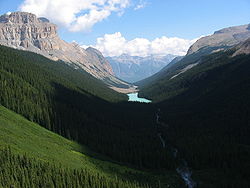 |
Alberta Alberta Alberta is a province of Canada. It had an estimated population of 3.7 million in 2010 making it the most populous of Canada's three prairie provinces... |
1907 | |
| Kejimkujik Kejimkujik National Park Kejimkujik National Park is part of the Canadian National Parks system, located in the province of Nova Scotia... |
Nova Scotia Nova Scotia Nova Scotia is one of Canada's three Maritime provinces and is the most populous province in Atlantic Canada. The name of the province is Latin for "New Scotland," but "Nova Scotia" is the recognized, English-language name of the province. The provincial capital is Halifax. Nova Scotia is the... |
1968 | ||
| Kluane Kluane National Park and Reserve Kluane National Park and Reserve are two units of Canada's national park system, located in the extreme southwestern corner of Yukon Territory. Kluane National Park Reserve was established in 1972, covering 22,016 square kilometres.... |
Yukon Yukon Yukon is the westernmost and smallest of Canada's three federal territories. It was named after the Yukon River. The word Yukon means "Great River" in Gwich’in.... |
1972 | ||
| Kootenay Kootenay National Park Kootenay National Park is located in southeastern British Columbia Canada covering in the Canadian Rockies and forms part of a World Heritage Site. The park ranges in elevation from at the south-west park entrance to at Deltaform Mountain... |
 |
British Columbia British Columbia British Columbia is the westernmost of Canada's provinces and is known for its natural beauty, as reflected in its Latin motto, Splendor sine occasu . Its name was chosen by Queen Victoria in 1858... |
1920 | |
| Kouchibouguac Kouchibouguac National Park Kouchibouguac National Park is located on the east coast of New Brunswick, north of the town of Richibucto. The park includes barrier islands, sand dunes, lagoons, salt marshes and forests. It provides habitat for seabirds, including the endangered Piping Plover, and the second largest tern colony... |
New Brunswick New Brunswick New Brunswick is one of Canada's three Maritime provinces and is the only province in the federation that is constitutionally bilingual . The provincial capital is Fredericton and Saint John is the most populous city. Greater Moncton is the largest Census Metropolitan Area... |
1969 | ||
| La Mauricie La Mauricie National Park La Mauricie National Park is located in the Laurentian mountains in the Mauricie region of Québec, Canada. It covers 536 km² in the southern Canadian Shield region bordering the Saint Lawrence lowlands. The park contains 150 lakes and many ponds.... |
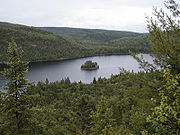 |
Quebec Quebec Quebec or is a province in east-central Canada. It is the only Canadian province with a predominantly French-speaking population and the only one whose sole official language is French at the provincial level.... |
1970 | |
| Mingan Archipelago Mingan Archipelago National Park Reserve The Mingan Archipelago National Park Reserve is a national park reserve located in the eastern area of Quebec, Canada, on the north shore of Gulf of St. Lawrence. It features the Mingan Archipelago, a chain of around 40 islands.... (Reserve) |
Quebec Quebec Quebec or is a province in east-central Canada. It is the only Canadian province with a predominantly French-speaking population and the only one whose sole official language is French at the provincial level.... |
1984 | ||
| Mount Revelstoke Mount Revelstoke National Park Mount Revelstoke National Park is located adjacent to the city of Revelstoke, British Columbia, Canada. The park is relatively small for a national park, covering 260 square kilometres. It is located in the Selkirk Mountains and was founded in 1914... |
 |
British Columbia British Columbia British Columbia is the westernmost of Canada's provinces and is known for its natural beauty, as reflected in its Latin motto, Splendor sine occasu . Its name was chosen by Queen Victoria in 1858... |
1914 | |
| Nahanni Nahanni National Park Reserve Nahanni National Park Reserve in the Dehcho Region of the Northwest Territories, Canada, approximately west of Yellowknife, protects a portion of the Mackenzie Mountains Natural Region. The centrepiece of the park is the South Nahanni River. Four noteworthy canyons reaching in depth, called... (Reserve) |
Northwest Territories Northwest Territories The Northwest Territories is a federal territory of Canada.Located in northern Canada, the territory borders Canada's two other territories, Yukon to the west and Nunavut to the east, and three provinces: British Columbia to the southwest, and Alberta and Saskatchewan to the south... |
1976 | ||
| Pacific Rim Pacific Rim National Park Reserve Pacific Rim National Park Reserve is a Canadian national park reserve in British Columbia made up of three separate regions: Long Beach, the Broken Group Islands, and the West Coast Trail. The entire park encompasses 511 km² of land and ocean. The park is characterized by rugged coasts and... (Reserve) |
 |
British Columbia British Columbia British Columbia is the westernmost of Canada's provinces and is known for its natural beauty, as reflected in its Latin motto, Splendor sine occasu . Its name was chosen by Queen Victoria in 1858... |
1970 | |
| Point Pelee Point Pelee National Park -See also:*National Parks of Canada*List of National Parks of Canada*Long Point-External links:**... |
Ontario Ontario Ontario is a province of Canada, located in east-central Canada. It is Canada's most populous province and second largest in total area. It is home to the nation's most populous city, Toronto, and the nation's capital, Ottawa.... |
1918 | ||
| Prince Albert Prince Albert National Park Prince Albert National Park covers in central Saskatchewan, Canada and is located north of Saskatoon. Though declared a national park March 24, 1927, it had its official opening ceremonies on August 10, 1928 performed by Prime Minister William Lyon Mackenzie King. The park is open all year but... |
Saskatchewan Saskatchewan Saskatchewan is a prairie province in Canada, which has an area of . Saskatchewan is bordered on the west by Alberta, on the north by the Northwest Territories, on the east by Manitoba, and on the south by the U.S. states of Montana and North Dakota.... |
1927 | ||
| Prince Edward Island Prince Edward Island National Park Prince Edward Island National Park is a National Park located on Prince Edward Island. Situated along the island's north shore, fronting the Gulf of St. Lawrence, the park measures approximately 60 km in length and ranges from several hundred metres to several kilometres in width... |
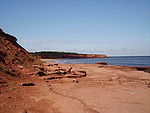 |
Prince Edward Island Prince Edward Island Prince Edward Island is a Canadian province consisting of an island of the same name, as well as other islands. The maritime province is the smallest in the nation in both land area and population... |
1937 | |
| Pukaskwa Pukaskwa National Park Pukaskwa National Park is a national park located south of the town of Marathon, Ontario in the Thunder Bay District of northern Ontario, Canada. Established in 1978, Pukaskwa is known for its vistas of Lake Superior and boreal forests... |
 |
Ontario Ontario Ontario is a province of Canada, located in east-central Canada. It is Canada's most populous province and second largest in total area. It is home to the nation's most populous city, Toronto, and the nation's capital, Ottawa.... |
1978 | |
| Quttinirpaaq Quttinirpaaq National Park -See also:*List of National Parks of Canada*List of protected areas of Nunavut*Arctic Cordillera-External links:**... |
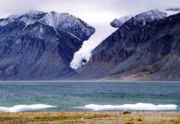 |
Nunavut Nunavut Nunavut is the largest and newest federal territory of Canada; it was separated officially from the Northwest Territories on April 1, 1999, via the Nunavut Act and the Nunavut Land Claims Agreement Act, though the actual boundaries had been established in 1993... |
2001 | |
| Riding Mountain Riding Mountain National Park Riding Mountain National Park is a national park in Manitoba, Canada. The park sits atop the Manitoba Escarpment. Consisting of a protected area , the forested parkland stands in sharp contrast to the surrounding prairie farmland. The park is home to wolves, moose, elk, black bears, hundreds of... |
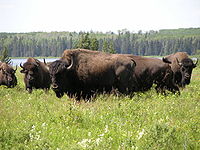 |
Manitoba Manitoba Manitoba is a Canadian prairie province with an area of . The province has over 110,000 lakes and has a largely continental climate because of its flat topography. Agriculture, mostly concentrated in the fertile southern and western parts of the province, is vital to the province's economy; other... |
1933 | |
| Sirmilik Sirmilik National Park Sirmilik National Park is a protected area located in Qikiqtaaluk, Nunavut, Canada. It was established in 2001. Situated within the Arctic Cordillera, it is composed of three areas: most of Bylot Island with the exception for a few areas that are Inuit-owned lands, Oliver Sound, and Baffin... |
 |
Nunavut Nunavut Nunavut is the largest and newest federal territory of Canada; it was separated officially from the Northwest Territories on April 1, 1999, via the Nunavut Act and the Nunavut Land Claims Agreement Act, though the actual boundaries had been established in 1993... |
2001 | |
| St. Lawrence Islands St. Lawrence Islands National Park St. Lawrence Islands National Park is located in the Thousand Islands Region of the Saint Lawrence River. The islands are actually the worn-down tops of ancient mountains... |
Ontario Ontario Ontario is a province of Canada, located in east-central Canada. It is Canada's most populous province and second largest in total area. It is home to the nation's most populous city, Toronto, and the nation's capital, Ottawa.... |
1904 | ||
| Terra Nova Terra Nova National Park Terra Nova National Park is located on the east coast of Newfoundland in the Canadian province of Newfoundland and Labrador, along several inlets of Bonavista Bay... |
Newfoundland Newfoundland and Labrador Newfoundland and Labrador is the easternmost province of Canada. Situated in the country's Atlantic region, it incorporates the island of Newfoundland and mainland Labrador with a combined area of . As of April 2011, the province's estimated population is 508,400... |
1957 | ||
| Torngat Mountains |  |
Labrador Newfoundland and Labrador Newfoundland and Labrador is the easternmost province of Canada. Situated in the country's Atlantic region, it incorporates the island of Newfoundland and mainland Labrador with a combined area of . As of April 2011, the province's estimated population is 508,400... |
2005 | |
| Tuktut Nogait Tuktut Nogait National Park Tuktut Nogait National Park is a national park located in the Northwest Territories of Canada. Meaning "young caribou" in Inuvialuktun, the park contains many herds of caribou. However, it is also the home to other wildlife species, such as Musk Ox, Grizzly Bears, Arctic char, and the Grey Wolf... |
Northwest Territories Northwest Territories The Northwest Territories is a federal territory of Canada.Located in northern Canada, the territory borders Canada's two other territories, Yukon to the west and Nunavut to the east, and three provinces: British Columbia to the southwest, and Alberta and Saskatchewan to the south... |
1996 | ||
| Ukkusiksalik Ukkusiksalik National Park Ukkusiksalik National Park is a national park in Nunavut, Canada.Ukkusiksalik National Park is a tundra and coastal mudflat region extending south of the Arctic Circle and the hamlet of Repulse Bay, from Hudson Bay's Roes Welcome Sound towards the western Barrenlands and the source of Brown River.... |
 |
Nunavut Nunavut Nunavut is the largest and newest federal territory of Canada; it was separated officially from the Northwest Territories on April 1, 1999, via the Nunavut Act and the Nunavut Land Claims Agreement Act, though the actual boundaries had been established in 1993... |
2003 | |
| Vuntut Vuntut National Park Vuntut National Park is a national park located in the northern Yukon, Canada. It was established in 1995. Due to land claims negotiations, this national park is still very undeveloped. It currently has no roads or developed trails.... |
Yukon Yukon Yukon is the westernmost and smallest of Canada's three federal territories. It was named after the Yukon River. The word Yukon means "Great River" in Gwich’in.... |
1995 | ||
| Wapusk Wapusk National Park Wapusk National Park is Canada's 37th national park, established in 1996. The park is located in the Hudson Plains ecozone, 45 km south of Churchill in north-east Manitoba, Canada, on the shores of Hudson Bay. Access to the park is limited due to its remote location and an effort to preserve... |
Manitoba Manitoba Manitoba is a Canadian prairie province with an area of . The province has over 110,000 lakes and has a largely continental climate because of its flat topography. Agriculture, mostly concentrated in the fertile southern and western parts of the province, is vital to the province's economy; other... |
1996 | ||
| Waterton Lakes Waterton Lakes National Park Waterton Lakes National Park is a national park located in the southwest corner of Alberta, Canada, and borders Glacier National Park in Montana, USA. Waterton was Canada's fourth national park, formed in 1895 and named after Waterton Lake, in turn after the Victorian naturalist and conservationist... |
Alberta Alberta Alberta is a province of Canada. It had an estimated population of 3.7 million in 2010 making it the most populous of Canada's three prairie provinces... |
1895 | ||
| Wood Buffalo Wood Buffalo National Park Wood Buffalo National Park, located in northeastern Alberta and southern Northwest Territories, is the largest national park in Canada at . The park was established in 1922 to protect the world's largest herd of free roaming Wood Bison, currently estimated at more than 5,000... |
Alberta Alberta Alberta is a province of Canada. It had an estimated population of 3.7 million in 2010 making it the most populous of Canada's three prairie provinces... Northwest Territories Northwest Territories The Northwest Territories is a federal territory of Canada.Located in northern Canada, the territory borders Canada's two other territories, Yukon to the west and Nunavut to the east, and three provinces: British Columbia to the southwest, and Alberta and Saskatchewan to the south... |
1922 | ||
| Yoho Yoho National Park Yoho National Park is located in the Canadian Rocky Mountains along the western slope of the Continental Divide in southeastern British Columbia. Yoho NP is bordered by Kootenay National Park on the southern side and Banff National Park on the eastern side... |
British Columbia British Columbia British Columbia is the westernmost of Canada's provinces and is known for its natural beauty, as reflected in its Latin motto, Splendor sine occasu . Its name was chosen by Queen Victoria in 1858... |
1886 |
Future National Parks and National Park Reserves
| Name | Location | Area |
|---|---|---|
| Mealy Mountains National Park Reserve Mealy Mountains National Park Reserve Mealy Mountains National Park Reserve is a proposed national park in Canada, located in the Labrador region of Newfoundland and Labrador. It will cover an area of approximately . Along with the Mealy Mountains, the park will protect a large portion of boreal forest, tundra and 50 kilometres of... |
Labrador Newfoundland and Labrador Newfoundland and Labrador is the easternmost province of Canada. Situated in the country's Atlantic region, it incorporates the island of Newfoundland and mainland Labrador with a combined area of . As of April 2011, the province's estimated population is 508,400... |
11700 km² (4,517 sq mi) |
| Naats'ihch'oh National Park Reserve Naats'ihch'oh National Park Reserve Naats'ihch'oh National Park Reserve is a future national park in Canada, located in the South Nahanni River watershed in the Northwest Territories. The name means "stands like a porcupine" in the Dene language. It covers an area of approximately... |
Northwest Territories Northwest Territories The Northwest Territories is a federal territory of Canada.Located in northern Canada, the territory borders Canada's two other territories, Yukon to the west and Nunavut to the east, and three provinces: British Columbia to the southwest, and Alberta and Saskatchewan to the south... |
7600 km² (2,934 sq mi) |
| Thaydene Nene National Park Thaydene Nene National Park Thaydene Nene National Park is a proposed national park located on the northern edge of the boreal forest in the Northwest Territories, Canada... |
Northwest Territories Northwest Territories The Northwest Territories is a federal territory of Canada.Located in northern Canada, the territory borders Canada's two other territories, Yukon to the west and Nunavut to the east, and three provinces: British Columbia to the southwest, and Alberta and Saskatchewan to the south... |
Approx. |
| Rouge Valley National Park Rouge Park Rouge Park will become an urban national park located along the border of Toronto and Pickering, Ontario, Canada. It will be Canada's first national park within a municipality.... |
Ontario Ontario Ontario is a province of Canada, located in east-central Canada. It is Canada's most populous province and second largest in total area. It is home to the nation's most populous city, Toronto, and the nation's capital, Ottawa.... |
Approx. |
Abolished National Parks
| Name | Location | Established | Abolished |
|---|---|---|---|
| Buffalo National Park Buffalo National Park Buffalo National Park was created near the town of Wainwright in east central Alberta on June 5, 1909, closed in 1940, and delisted in 1947 when the land was transferred to the Department of National Defence. The park land now comprises the majority of Canadian Forces Base Wainwright... |
Alberta Alberta Alberta is a province of Canada. It had an estimated population of 3.7 million in 2010 making it the most populous of Canada's three prairie provinces... |
1909 | 1947 |
| Menissawok National Park Menissawok National Park Menissawok National Park was a national park established in 1922 southeast of the town of Maple Creek, Saskatchewan, in the southwest part of the Canadian province. It closed in 1930, and was delisted in 1947... |
Saskatchewan Saskatchewan Saskatchewan is a prairie province in Canada, which has an area of . Saskatchewan is bordered on the west by Alberta, on the north by the Northwest Territories, on the east by Manitoba, and on the south by the U.S. states of Montana and North Dakota.... |
1922 | 1930 |
| Nemiskam National Park Nemiskam National Park Nemiskam National Park was created north of the former community of Nemiskam in south central Alberta, Canada, in 1922. The park was closed and delisted in 1947. The first Park Superintendent was Edgar McHugh... |
Alberta Alberta Alberta is a province of Canada. It had an estimated population of 3.7 million in 2010 making it the most populous of Canada's three prairie provinces... |
1914 | 1947 |
| Wawaskesy National Park Wawaskesy National Park Wawaskesy National Park was created near the South Saskatchewan River, north of the town of Medicine Hat in southeastern Alberta, Canada, in 1922, closed in 1938, and delisted in 1947.... |
Alberta Alberta Alberta is a province of Canada. It had an estimated population of 3.7 million in 2010 making it the most populous of Canada's three prairie provinces... |
1922 | 1938 |
National Marine Conservation Areas
National Marine Conservation AreasNational Marine Conservation Areas
National Marine Conservation Areas is a Parks Canada programme responsible for marine areas managed for sustainability and containing smaller zones of high protection. They include the seabed, the water itself and any species which occur there...
(NMCAs) are a relatively new addition to the park system. These areas have a different mandate than their terrestrial counterparts. They are designed for sustainable use, although they usually also contain areas designed to protect ecological integrity. The government has announced plans to add five more Marine parks to the system as part of the Marine Conservation Areas Act. The first to be officially announced was Lake Superior National Marine Conservation Area
Lake Superior National Marine Conservation Area
The Lake Superior National Marine Conservation Area is a national marine conservation area on the north shore of Lake Superior, announced by Canadian Prime Minister Stephen Harper on October 25, 2007 at a press conference in Nipigon, Ontario...
, although a date of opening has not yet been revealed. Other areas under negotiation are the southern Strait of Georgia
Strait of Georgia
The Strait of Georgia or the Georgia Strait is a strait between Vancouver Island and the mainland coast of British Columbia, Canada. It is approximately long and varies in width from...
and Gwaii Haanas in British Columbia
British Columbia
British Columbia is the westernmost of Canada's provinces and is known for its natural beauty, as reflected in its Latin motto, Splendor sine occasu . Its name was chosen by Queen Victoria in 1858...
and there are discussions to study the feasibility of an area on the southern coast of Newfoundland
Newfoundland and Labrador
Newfoundland and Labrador is the easternmost province of Canada. Situated in the country's Atlantic region, it incorporates the island of Newfoundland and mainland Labrador with a combined area of . As of April 2011, the province's estimated population is 508,400...
.
| Name | Photo | Location | Area | Established |
|---|---|---|---|---|
| Fathom Five Fathom Five National Marine Park Fathom Five National Marine Park is a National Marine Conservation Area in the Georgian Bay part of Lake Huron, Ontario, Canada, that seeks to protect and display shipwrecks and lighthouses, and conserve freshwater ecosystems... |
 |
Ontario Ontario Ontario is a province of Canada, located in east-central Canada. It is Canada's most populous province and second largest in total area. It is home to the nation's most populous city, Toronto, and the nation's capital, Ottawa.... |
1987 | |
| Gwaii Haanas Gwaii Haanas National Marine Conservation Area Reserve and Haida Heritage Site Gwaii Haanas National Marine Conservation Area Reserve and Haida Heritage Site is a National Marine Conservation Area of Canada. It is located off the coast of the southernmost Haida Gwaii , 130 kilometres off the mainland of British Columbia. It is immediately adjacent to Gwaii Haanas National... (Reserve) |
British Columbia British Columbia British Columbia is the westernmost of Canada's provinces and is known for its natural beauty, as reflected in its Latin motto, Splendor sine occasu . Its name was chosen by Queen Victoria in 1858... |
2010 | ||
| Lake Superior Lake Superior National Marine Conservation Area The Lake Superior National Marine Conservation Area is a national marine conservation area on the north shore of Lake Superior, announced by Canadian Prime Minister Stephen Harper on October 25, 2007 at a press conference in Nipigon, Ontario... |
Ontario Ontario Ontario is a province of Canada, located in east-central Canada. It is Canada's most populous province and second largest in total area. It is home to the nation's most populous city, Toronto, and the nation's capital, Ottawa.... |
2007 | ||
| Saguenay-St. Lawrence |  |
Quebec Quebec Quebec or is a province in east-central Canada. It is the only Canadian province with a predominantly French-speaking population and the only one whose sole official language is French at the provincial level.... |
1998 |
National Landmark
In addition to national parks, a National LandmarksNational landmark
A National landmark is a site identified by a national authority as one possessing nationally–significant natural, historic, or scientific resources...
program was established in 1978 but has not yet been expanded beyond a single property. Landmarks were intended to protect specific natural features considered "outstanding, exceptional, unique, or rare to this country. These natural features would typically be isolated entities and of scientific interest."
| Name | Photo | Location | Area | Established |
|---|---|---|---|---|
| Pingo Pingo National Landmark Pingo National Landmark is a natural area protecting eight pingos near Tuktoyaktuk, Northwest Territories. It is in a coastal region of the Arctic Ocean which contains approximately 1,350 Arctic ice dome hills—approximately one quarter of the world's pingos.The Landmark comprises an area... |
 |
Northwest Territories Northwest Territories The Northwest Territories is a federal territory of Canada.Located in northern Canada, the territory borders Canada's two other territories, Yukon to the west and Nunavut to the east, and three provinces: British Columbia to the southwest, and Alberta and Saskatchewan to the south... |
16 km² (6 sq mi) | 1984 |
See also
Provincial parks are administered and funded by the provincial governments, however some provincial parks are categorized as national parkNational park
A national park is a reserve of natural, semi-natural, or developed land that a sovereign state declares or owns. Although individual nations designate their own national parks differently A national park is a reserve of natural, semi-natural, or developed land that a sovereign state declares or...
s (Category II) under the IUCN's Protected Area Management Categories.
- List of Canadian provincial parks
- List of Alberta provincial parks
- List of British Columbia provincial parks
- List of Ontario Parks (national and provincial)
- List of Quebec national parks (provincial parks in QuebecQuebecQuebec or is a province in east-central Canada. It is the only Canadian province with a predominantly French-speaking population and the only one whose sole official language is French at the provincial level....
are called "national" parks by the provincial government)
- List of UNESCO Biosphere Reserves in Canada
- List of national historic sites of Canada.

